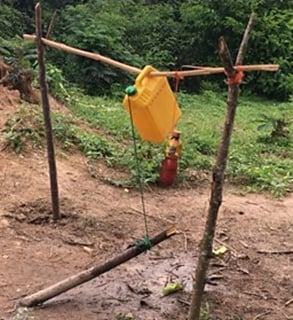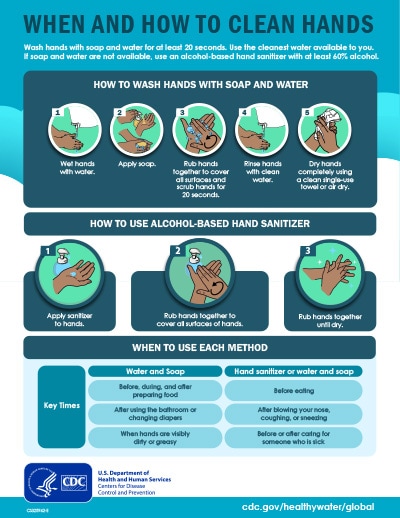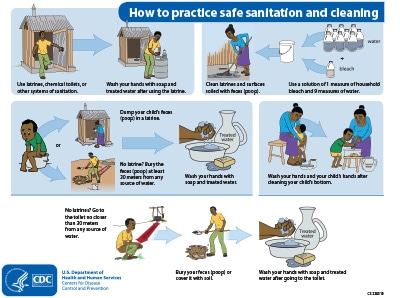Hygiene in Resource-Limited Settings
Hygiene refers to practices that can lead to good health and cleanliness, such as frequent handwashing, face washing, and bathing with soap and water. Keeping hands clean is one of the most important ways to prevent the spread of illness, including diarrheal and respiratory illnesses. However, in many areas of the world, practicing personal hygiene is difficult due to lack of access to necessities such as clean water and soap.
Hand hygiene is one of the most effective ways to prevent the spread of germs. Yet globally:
- 2.3 billion people don’t have access to a handwashing facility with water and soap at home1
- 670 million don’t have access to a handwashing facility at all1
- 462 million children don’t have access to handwashing facilities at schools1
Find the latest statistics on access to clean water, sanitation, and hygiene around the world.
In many resource-limited settings, diarrheal disease is the leading cause of death among children. However, a recent review of data from several studies showed that a 30% reduction in diarrhea can occur when handwashing with soap and water is introduced into a community.2 Thus, hygiene promotion and interventions could prevent an estimated 1 million deaths from diarrheal diseases.3
Respiratory diseases are also common in resource-limited settings: in 2016 there were almost 300 million estimated cases and almost 2 million deaths due to lower respiratory infections alone.4 Although more systematic evidence is needed, multiple studies show hand hygiene interventions can reduce respiratory diseases generally, as well as in childcare settings and schools.5,6
Diarrheal and respiratory diseases are spread by person-to-person contact, often by way of contaminated hands. Diarrheal diseases can also be spread through fecal-oral routes facilitated by contaminated hands. Handwashing can stop the spread of many bacteria, parasites, and viruses that cause disease. Handwashing is integral to disease prevention in all parts of the world; however, access to soap and water is limited in many resource-limited settings.
Many challenges and barriers to good hygiene exist in resource-limited settings. The greatest of these challenges is the lack of access to water.
- About 2 billion people do not have access to safely managed drinking water services, of which 800 million people do not have access to an improved water source and lack safe drinking water4
- Worldwide, 1.6 million deaths per year are attributed to diseases spread through unsafe water, poor sanitation, and lack of hygiene.4
- Handwashing is one of the most effective ways to prevent the spread of germs. Yet 2.3 billion people do not have access to a handwashing facility with water and soap at home, and 670 million people lack access to a handwashing facility at all.1
This lack of access is one of many challenges to practicing hygiene at key times in resource-limited settings. Effective handwashing interventions involve education and promoting long-term behavior changes in appropriate social and cultural contexts.
One innovation designed to provide a simple, economical, and effective handwashing station to communities in resource-limited settings is the tippy tap. This device uses significantly less soap and water than other, traditional means of handwashing.
Programs that provide education about and access to water are integral to the improvement of water resources in resource-limited settings. However, hygiene challenges remain a significant problem for millions of people.
Personal Hygiene
Regular handwashing is one of the best ways to remove germs and prevent the spread of disease and illness. Key times to clean hands include:
- Before, during, and after preparing food
- Before eating food
- Before and after caring for someone who is sick
- Before and after treating a cut or wound
- After using the toilet
- After changing diapers or cleaning up a child who has used the toilet
- After blowing nose, coughing, or sneezing
- After touching an animal, animal feed, or animal waste
- After handling pet food or pet treats
- After touching garbage
When soap and water are not readily available and especially if hands are not visibly dirty, an alcohol-based hand sanitizer with at least 60% alcohol should be used to reduce the number of germs on hands.
- Apply enough product to cover all surfaces of both hands and rub together until they feel dry, usually about 20 seconds.
- Supervise young children when using hand sanitizer to prevent accidental swallowing.
If soap and water or alcohol-based hand sanitizer are unavailable, hands can be washed with a 0.05% chlorine solution [PDF – 1 page]. Important safety measures to consider:
Chlorine-based handwashing solutions should only be used when soap and water or alcohol-based hand sanitizer are not available.
- Unused chlorine solution should be safely discarded at the end of each day in a toilet or a drain connected to a septic system or sewer.
- Users should exercise caution to avoid getting the chlorine solution in their eyes or mouth, including not drinking the solution.
- Provide those mixing the solution with personal protective equipment (rubber gloves, thick aprons, closed shoes, face masks, and eye protection).
Many diseases and conditions can also be prevented or controlled through proper personal hygiene by:
- Cleaning teeth regularly with toothpaste, a toothbrush, and safe water (preferably treated, running water, if available).
- Frequently washing other parts of the body and hair with soap and running water (if available):
- Trachoma infection can be prevented through increased facial cleanliness using soap and water, and safely managed sanitation to reduce fly breeding sites.
- People with lymphatic filariasis can prevent secondary bacterial and fungal infections and decrease the risk of lymphedema progressing to elephantiasis by daily washing the swollen area (usually the limbs) with soap and water, as well as disinfecting wounds with antibacterial or antifungal cream.
Environmental hygiene
Practicing safe sanitation and cleaning is critical in preventing the spread of diseases. Cleaning and disinfecting surfaces, especially hard, non-porous surfaces, as needed with appropriate products reduces the number of germs on surfaces and decreases risk of infection from surfaces.
- Cleaning uses soap or detergent to remove germs, dirt, and impurities from surfaces, ultimately lowering the risk of spreading infection.
- Disinfecting uses chemicals, such as bleach (sodium hypochlorite), to kill germs on surfaces, which can lower the risk of spreading infection. For many disinfection tasks, a 0.1% solution made from liquid bleach and water can be used.
- Mix 20 ml of 5% bleach with 980 ml of water to make 1 liter of bleach solution.
- Apply the 0.1% solution to the surface with a cloth. The surface should stay wet for at least 1 minute. After 1 minute has passed, rinse residue with clean water.
- Disinfection products can cause harm to users, so it is important for individuals to be adequately protected in the mixing and disinfection process and trained on how to safely mix and disinfect.
For safety guidelines when using chemical disinfectants, visit When and How to Clean and Disinfect Your Home.
- World Health Organization and UNICEF. State of the World’s Hand Hygiene: A global call to action to make hand hygiene a priority in policy and practice. UNICEF, New York, 2021.
- Wolf J, Hunter PR, Freeman MC, et al. Impact of drinking water, sanitation and handwashing with soap on childhood diarrhoeal disease: updated meta-analysis and meta-regression. Trop Med Int Health. 2018;23(5):508-525. doi:10.1111/tmi.13051
- Curtis V, Cairncross S. Effect of Washing Hands With Soap On Diarrhea Risk In The Community: A Systematic Review. Lancet Infect Dis. 2003;3(5):275-81.
- GBD 2016 Lower Respiratory Infections Collaborators. Estimates of the global, regional, and national morbidity, mortality, and aetiologies of lower respiratory infections in 195 countries, 1990-2016: a systematic analysis for the Global Burden of Disease Study 2016. Lancet Infect Dis. 2018;18(11):1191-1210. doi:10.1016/S1473-3099(18)30310-4
- Mbakaya BC, Lee PH, Lee RL. Hand Hygiene Intervention Strategies to Reduce Diarrhoea and Respiratory Infections among Schoolchildren in Developing Countries: A Systematic Review. Int J Environ Res Public Heal [Electronic Resour [Internet]. 2017;14(4):1.
- Warren-Gash C, Fragaszy E, Hayward AC. Hand hygiene to reduce community transmission of influenza and acute respiratory tract infection: a systematic review. Influenza Other Respir Viruses. 2013;7(5):738-749. doi:10.1111/irv.12015
- World Health Organization and UNICEF. Progress on household drinking water, sanitation, and Hygiene – Five Years into the SDGs. 2020.


